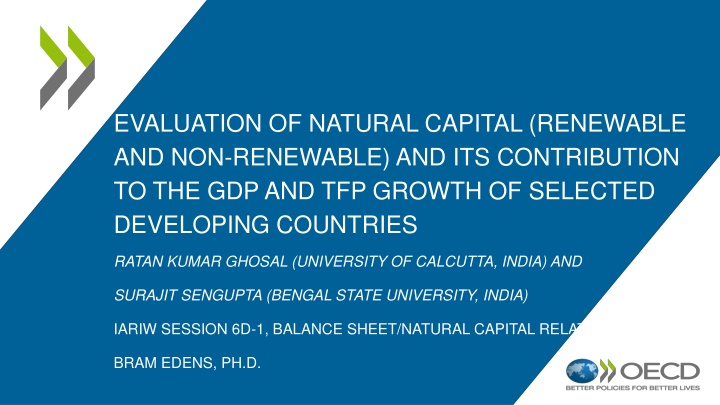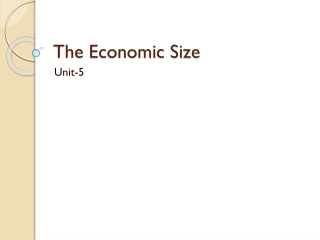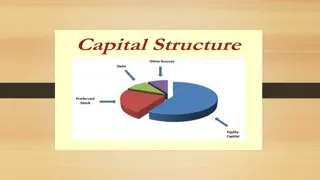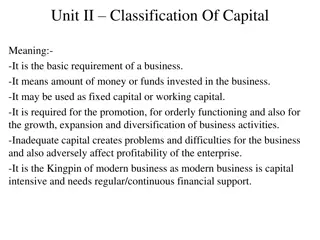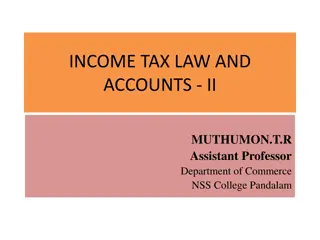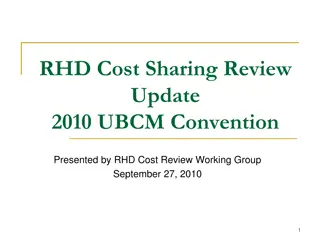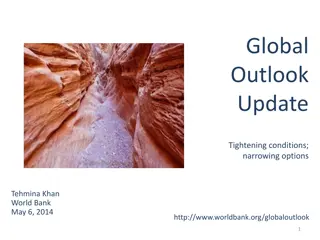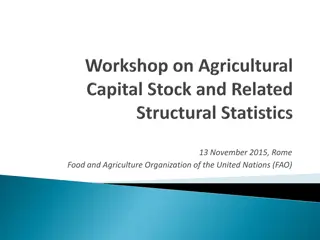Evaluation of Natural Capital Contribution in Developing Economies
This study assesses the impact of natural capital (renewable and non-renewable) on GDP and total factor productivity (TFP) growth in selected developing countries. The research explores the role of natural resources in economic advancement, addressing biases in productivity estimates and examining the variations across nations over time. Various approaches are employed to measure TFP growth, highlighting the significance of including natural capital in productivity analysis.
Download Presentation

Please find below an Image/Link to download the presentation.
The content on the website is provided AS IS for your information and personal use only. It may not be sold, licensed, or shared on other websites without obtaining consent from the author.If you encounter any issues during the download, it is possible that the publisher has removed the file from their server.
You are allowed to download the files provided on this website for personal or commercial use, subject to the condition that they are used lawfully. All files are the property of their respective owners.
The content on the website is provided AS IS for your information and personal use only. It may not be sold, licensed, or shared on other websites without obtaining consent from the author.
E N D
Presentation Transcript
EVALUATION OF NATURAL CAPITAL (RENEWABLE AND NON-RENEWABLE) AND ITS CONTRIBUTION TO THE GDP AND TFP GROWTH OF SELECTED DEVELOPING COUNTRIES RATAN KUMAR GHOSAL (UNIVERSITY OF CALCUTTA, INDIA) AND SURAJIT SENGUPTA (BENGAL STATE UNIVERSITY, INDIA) IARIW SESSION 6D-1, BALANCE SHEET/NATURAL CAPITAL RELATED ISSUES BRAM EDENS, PH.D.
Outline Objective Model / strategy Data sources Results Discussion / suggestions Unclassified - Non classifi
Objective Motivation: The most crucial and quintessential factor playing a major role to the generation of income of every economy i.e the natural resource and environment as an input factor are still generally ignored in the MFP used in these studies nevertheless the rental income generated through the depletion of the natural capital such as minerals, fossil fuels is incorporated in the value of GDP and in profit When natural capital is taken into account, mostly non-renewable resources Negative externalities .. which may cause a growth drag .. None of the studies has considered human capital as a contributing factor so that there has still been an upward biasness in the estimation of productivity growth Unclassified - Non classifi
Objectives How could the contribution of the total natural resource (viz; renewable and nonrenewable) to the economic growth and the TFPG of the economy be captured explicitly and correctly without any bias in estimation? How does the role of natural capital in terms of its contribution to economic growth and TFPG really vary across the developing countries over time? How do the contributions of other factors get affected if we include the natural capital in MFP? Unclassified - Non classifi
Approaches 3 different approaches towards measuring TFPG Approach A: Factor cost share weighted estimation of contributions Approach B: Production elasticity based computation of contributions Approach C: Dynamic panel regression with Generalized Method of Moment (GMM) technique for determining cross-country and cross-time valuation in the growth of real GDP per-capita and relative role of the factors of production Approaches A and B: the same method is applied 4 times by leaving out 1 or more of the factors, and comparing the results L,K, H,N L,K,N L,K L,K,H Unclassified - Non classifi
Scope 14 developing countries: Chosen our sample countries along with period of analysis for the panel exclusively on the basis of the availability of the country specific longitudinal data base on all the factor inputs and the pertinent factors required for our estimations Period 1995-2020 But: Now, we have used extrapolation method for extending database on the variable used in our study for the years 2019 and 2020 Unclassified - Non classifi
Methods and data: Approach A (1) User cost shares + neo-classical production function Y(it) = A(it) * F(L(it), K(it), H(it), N(it)) Here i = 1 ............... 14 for developing country panel t = time period 1995 .. 2020 Where Y = Real GDP (at 2017 constant international$ PPP) L = Labour measured in hours K = Stock of physical capital (expressed at 2018 constant US$ PPP) N = Stock of natural capital (renewable + non-renewable)(at constant 2018 US$ PPP) H = Stock of human capital estimated at constant 2018 US$ PPP A = Measure of the TFP Unclassified - Non classifi
Methods and data: Approach A (2) User cost shares: Human capital: total expenditure on education and health of the respective countries as user cost of human capital of the countries Natural capital: World Bank CWON Deduct sum total of user costs of human capital and natural capital from GDP Distribute the residual as compensation to labour and physical capital by using the ratio of labor compensation and capital compensation originally given in the Conference Board Total Economy Database This gives user cost shares of each factor for the period for each country such that the sum of the cost shares be equal to one For each year: Real GDP growth rate + growth contribution of each factor TFPG obtained as residual Cross time sum Simple average across all periods to obtain results for each factor and TFPG Unclassified - Non classifi
Methods and data: Approach B (1) Cobb-Douglas production function + production elasticities of factor inputs Y = At Kt kL LHt hNt n log Ylt = log At + k (log Kt) + L (Log Lt) + h (log Ht) + n (Log Nt) OLS to find each Beta Multiply Beta with growth of each factor TFPGt = Yt / Yt - j ( Xj / Xj) (assumption that elasticity remains constant over time) For each year: Real GDP growth rate + growth contribution of each factor (and hence TFPG) Cross time sum Simple average across all periods Unclassified - Non classifi
Methods and data: Approach C Dynamic panel regression with GMM estimators of Arellano- Bond for both the panels of developed and developing countries separately lnYit lnYit-1 = ( -1) lnYit-1 + lnXit + ui + it Factors all expressed per capita Eliminate country specific effect (ui) to obtain: lnYit = lnYit -1 + lnXit + it Unclassified - Non classifi
Results: Approach A (1) Pakistan highest contribution of labour China of K Chili of N China of H Tajikistan highest TFPG followed by China Unclassified - Non classifi
Results: Approach A (2) Unexpected -> negative numbers Take Indonesia: we had 0.66 now we leave out HC and get 0.57 -> seems counterintu itive Unclassified - Non classifi
Results: Approach B (1) Results between Approach A and B are quite different China: TFPG 0.31 (3.78 in Approach A) Countries like Indonesia becoming negative Unclassified - Non classifi
Results: Approach C All factors of production have positive and statistically significant impact Including growth of lagged GDP Excepting China, impact of growth of natural capital on per capita GDP growth found to be minimum compared to other factors Unclassified - Non classifi
Conclusions (1) Approach A: Cost share method: Contribution of natural capital lower than that of other factors (except China). The richer the human capital base of a country the more efficient utilization of other factors including natural capital Natural capital has played a crucial role improvement in TFPG for at least fifty percent of all countries (e.g. Chili, South Africa and China). Now the plausible explanation behind the decline in TFPG for the rest of the 50% of the selected countries despite the presence of natural capital can be outlined as follows : (a) continuous extraction of non-renewable natural capitals over the last few decades has made these natural resources scarce and costly and so factor substitution seems to have taken place (b) it is true that the developing countries are suffering from abject poverty coupled with inequality in the distribution of income, technological backwardness and existence of poor human capital base. All these seems to have made extraction of natural capital costly so the extraction of natural capital might have been unaffordable and (c) rampant use of different kinds of renewable natural resources unaccompanied by required and timely adequate replenishment for compensating the loss in time seems to have caused relatively smaller contribution of natural capital to the growth of TFPG. Unclassified - Non classifi
Conclusions (2) Results of Approach A and B: Role of natural capital towards the total factor productivity growth is less compatible. Results Approach C: Growth of all factors of production has positive and significant impact on the growth of per-capita real GDP. Interestingly, when we drop natural capital from MFP the growth contributions of other factors like physical capital, human capital get blurred. The rampant extraction of natural capital (both renewable and non-renewable) without proper supplementation of renewable natural capital seems to have worsened ecological balance thereby causing decline in the productivity level of other factors through strongly adverse effect of climate change. Unclassified - Non classifi
Suggestions (1) Make it easier for your readers Long paper -> helpful to condense Ensure all abbreviations / acronyms are introduced Methods section-> a bit confusing Motivations + objectives: Literature review: OECD has done a new release (Environmentally adjusted multifactor productivity: accounting for renewable natural resources and ecosystem services, 2023) Interesting to compare with OECD results Unclassified - Non classifi
Suggestions (2) You try to do a lot in one paper (look at role of N and of H, comparing different approaches) Unclear (to me) why methods give such different results: Paper would benefit from a clear conclusion which approach provides best results Substantive questions: Overlap / double counting between L and H ? Would it not be logical to look at IPPs / innovation directly ? Separate out renewable and non-renewable capital? Factor input costs: why force them to sum to 1? Factors (including some N) are traded in markets and have explicit prices Unclassified - Non classifi
